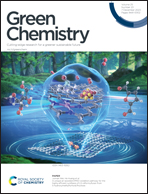Extending the high-performing boundaries of a fully bio-based thermal shrinkage film targeted for food packaging applications†
Abstract
While modern research into biodegradable and renewable plastics has expanded to cover a wide variety of applications, some characteristics, such as desirable elastic properties, are still difficult to achieve without the use of petroleum-based monomers. In addition, 100% biomass-based polymers are in high demand as environmental regulations increasingly require the use of biomass-based monomers. In this study, biomass-derived monomers, such as adipic acid (AA), 2,5-furandicarboxylic acid (FDCA), and 1,3-propanediol (PDO), were used to synthesize terpolyesters with elastic properties. The unsymmetrical structure of FDCA led to a spiral motif that biodegrades efficiently, and its ring structure also plays an important role as a hard elastomer domain. Applying the “odd–even effect” of PDO resulted in very high biodegradation rates, low melting points, and low degrees of crystallinity. An FDCA : AA ratio of 7 : 3 led to an elongation of around 600% and a recovery rate of 89% (to the original state) at a fixed PDO concentration.



 Please wait while we load your content...
Please wait while we load your content...